While the Indianapolis 500 looms large in the minds of enthusiasts when it comes to racing in America, most of what was available to our ancestors was a more low-budget affair. Bullrings all over the country were filled on Friday and Saturday nights with homemade stock cars tearing around dirt tracks piloted by brave drivers trying to win races and stay alive in a rough and tumble period of our history. Their weapon of choice was almost always a prewar Ford coupe like this 1932 Ford coupe for sale on Craigslist in Turner, Maine. This authentic 1932 Ford body is paired with a modified chassis and a later Flathead fortified with speed parts from the era. Is the $35,000 asking price reasonable for a real Ford body paired with a dog’s breakfast of period and modern parts and pieces?
Auto racing at a local level used to be a lot more popular than it is today. Nearly any town worth a couple of stoplights had a track of some sort. If you ever watched the documentary series “Lost Speedways” by Dale Earnhardt Jr. and Matt Dillner, you got a glimpse into just a few of the great racetracks that have passed into history. Those racetracks chronicled in that series are just a drop in the bucket. In Allen Brown’s book “The History of America’s Speedways Past and Present” the author states that there have been more than 8,000 racetracks of various types in America this century. Fewer than 2,000 remain today. With the growth of cities and suburbs, NIMBY types, and the cost of racing and insurance, that number gets smaller by the day.
Most of those tracks were not paved. Making a dirt oval was cheap and easy if you had the right type of soil. These were smaller tracks, but the larger the track, the better chance it was paved. While racing was common before the war, the sport exploded when those lucky enough to survive returned from war with the financial means to compete. Racing also acted as therapy of sorts for many. It was a way to replace the comradery and danger that was suddenly missing for many. Smokey Yunick discusses this aspect of racing in his fantastic biography “The Best Damn Garage in Town.” Smokey was a B-17 pilot during World War II. He started out helping Marshall Teague with his racing efforts. Teague was a navigator on a B-29. Many of their fellow competitors were also World War II veterans. The lists of NASCAR drivers, crew chiefs, and owners during the first decade of the sport were heavy with veterans craving the adrenaline rush that racing provided.
That adrenaline was provided by the cars they raced. Before Bill France came up with the idea of stock car racing, the sanctioning body’s main draw was the modified division. Modifieds were almost always prewar coupes modified for the rigors of racing by local mechanics, often from gas stations in the area they raced in. Early races were filled with a hodge podge of makes and models as this was a budget sport. However, serious competitors always drove Ford coupes. Ford’s Flathead V-8 was the engine of choice for the blossoming speed parts industry. There was also ample experience on both coasts with making a Flathead Ford faster. Out west, limits were being pushed on the salt flats. In the South, roads such as Georgia 400 were the test tracks of choice, often at night with law enforcement trying to keep up.
A typical Ford coupe raced during this period looked a lot like this 1932 Ford three-window coupe. The seller tells us that it is being sold for a widow. They state that it was found under the previous owner’s house in this condition. The only changes made were replacing the fuel pump, rubber lines, and wheels. One photo shows period mag wheels with bias ply whitewalls. However, the rest of the pictures show red steel wheels with radials mounted on them. Believe it or not, period-correct racing tires are available and would look fantastic on those steel wheels.
The body is said to be real steel, which we take to mean an authentic Ford body. If this is true, then the next owner may be a hot rod builder looking to make a period-correct car with Henry steel. Under the nonexistent hood is a later 24-stud Flathead V-8 with Edelbrock heads, a Fenton dial-carb manifold, and an alternator instead of a period-correct generator. There are also a few other pieces in the engine compartment that would have to be replaced to make the car closer to an original race car. It is backed up with what we assume to be a three-speed Ford manual transmission. The car is said to run, drive, and stop, but needs some work to run perfectly. Another interesting choice is the addition of disc brakes on the front. The chassis is one from a 1934 Ford with a tube shock conversion in the front, a conversion to coil springs in the rear, and a modified Ford 8″ rear end.
A peek inside reveals a late-model vinyl bench seat where a much-modified seat set up for racing should be. The steering wheel is from an early forties Ford and a modern set of instruments fill up the center of the dash. The original Ford emergency brake lever is still there along with what appears to be a particle board jump seat in the rear. Another interesting point is the door catches on the front pillar and another catch of some sort on the seat. If anyone can clarify what we are seeing, we would appreciate an explanation in the comments. Also, notice that there is no roll bar or other provisions for safety in the car at this time.
This car was possibly a race car at one time. From there, previous owners may have tried to keep the racecar genes, but have diluted the product a bit by adding street rod features to make it driveable on the street. A talented builder could tear this car apart and make a great period-correct racer out of it in short order. Hopefully, that is in this car’s future. Fords such as this one were sacrificed by the hundreds in tracks across this nation to bring racing to Americans hungry for entertainment after enduring one of the darkest periods in history. We need cars like this to tell that story.
What would you do with this car? Would you build it back as a street rod or make it into a period-correct race car? Please share your thoughts in the comments.
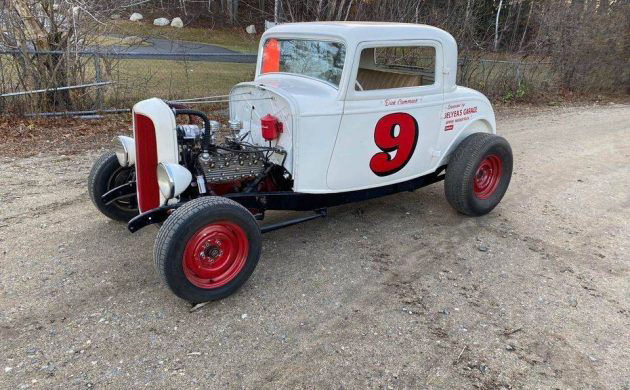
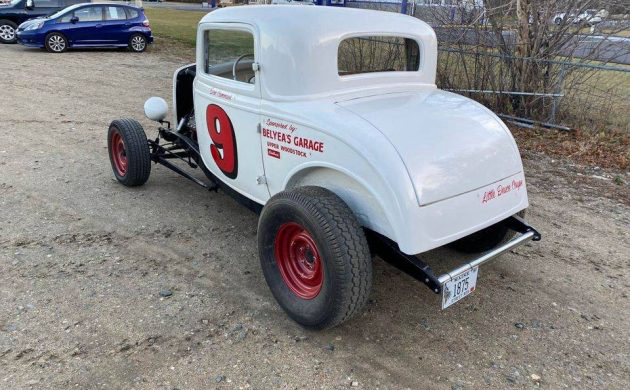
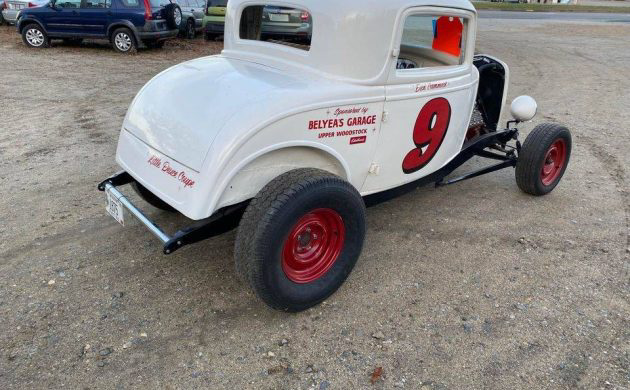

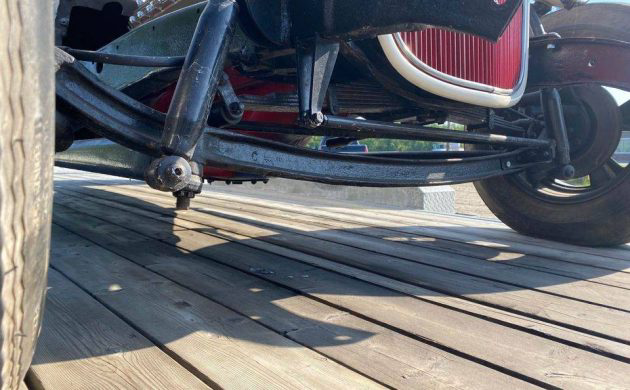

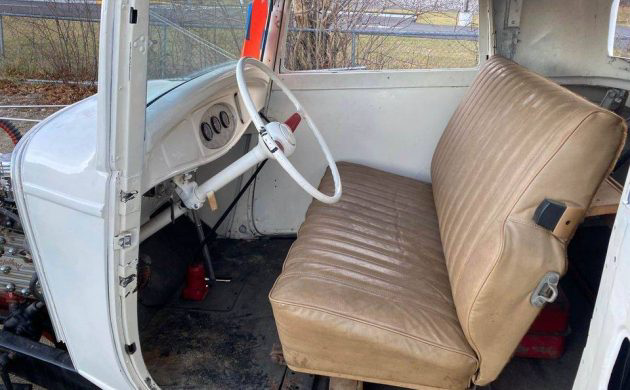


This is so cool, I want!!!!!. Add nerf bars, minimal guards (fenders for you yanks), and a few other things to make it street legal.
I wish I was around in the glory days that this car is based on, let’s bring it back.
Great writeup Jeff. Took me back to my youth in Denver Colorado in the late 60s and early 70s. I turned 16 in 1968 and would go to the racetracks with my brothers and my friends, even sometimes a ‘girl’. Englewood Speedway was one of my favorites, half mile dirt oval. We have an amusement park in Denver called Lakeside. They had a short oval track with racing every weekend in the summer. That racetrack is still standing, or what’s left of it. A local news guy did a story about it maybe a year ago. This is a cool 1932 three window, I don’t know what one could do with it. Just set it in the corner of the barn as a conversation piece.
Other than the number on the door and an unverified claim by the seller, nothing suggests any connection with racing. Google “jalopy dirt racer” then search images, this looks nothing like the cars on the track. Unless some documented history is provided, which a long time owners widow would likely possess, this story should be considered a sales tactic to drive up the price. It would likely draw a crowd at a coffee and cars, that’s enough for a lot of people.
Steve R
The body on this car looks solid and straight.
I’d put some windows in it paint it and turn it into a classic hot rod.
I used to go to the Reading (PA) Fairgrounds as a kid to watch the modified races. The body on this car appears too straight to have ever turned a lap on an oval but so what. I like the look of this and if it were mine I would want to go the street rod route with it.
At first glance, I thought “what a cool car”, but after reading the write up, (which was excellent by the way) while I still think that it is pretty nifty, it is not quite as cool as I initially thought it would be. I agree with Steve R, there is nothing that would really cause one to believe that it is a true jalopy racer survivor. It is someone’s attempt at creating that illusion, but that’s not what it is. It would still be kind of a cool car to tool around in, but not for the asking price.
Great writeup Jeff. Wouldn’t do anything to this but drive it on weekends. It’s history in it’s own right. No reason to modify history.
My local race track, which hosted oval and figure 8 racing and demo derbies, from the fifties until recently, closed a few years ago. The property has since been developed into a gated community.
Interesting comments! Woofer I also am from Denver, a little older than you and I grew up with Englewood and Lakeside Speedways. Comment on door latches I don’t know why but they just added a second latch. Now days they even make an after market pin lock for 32 3 windows and 34 Fords, I should put one on my 34 Coupe, but I haven’t. IMO I think this car is way over priced for what’s there. The 34 frame is not a plus, the only reason to do it is because you didn’t have a 32 frame. I really don’t know what I would do with it and I am not planning on finding out.
I doubt it was a racecar.
Headlamps for LeMans? Nah.
It looks more like a drag racer than a circle or oval track racer with the skinny tires up front and high stance.
Actually ,it doesn’t look like either one! It is just an eclectic bunch of parts bolted together.